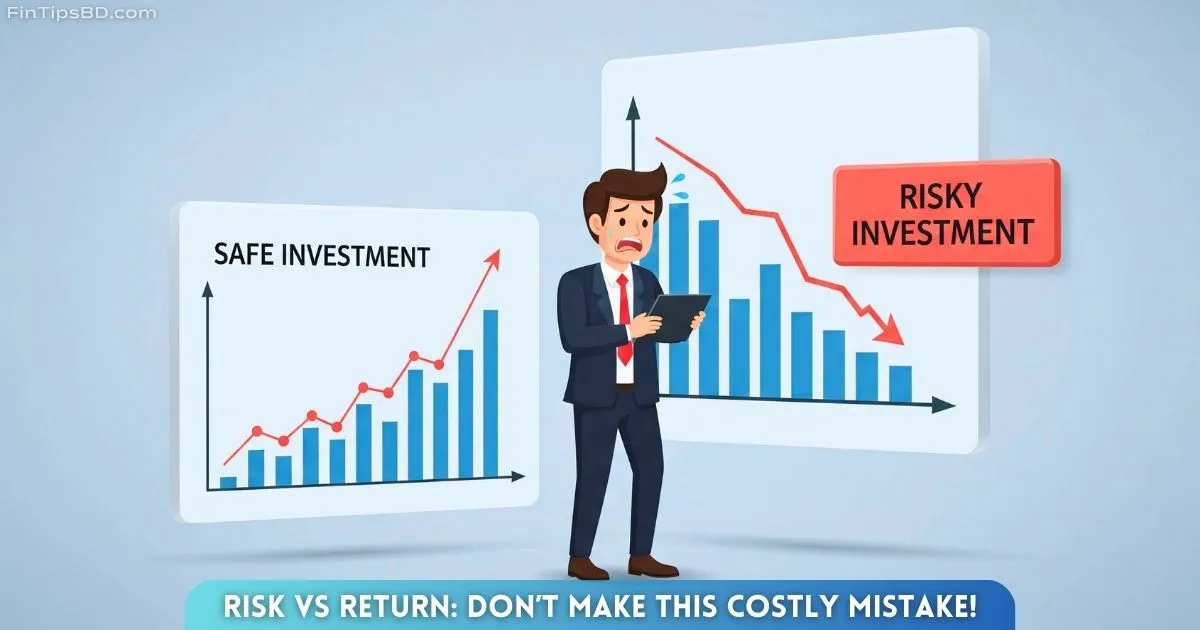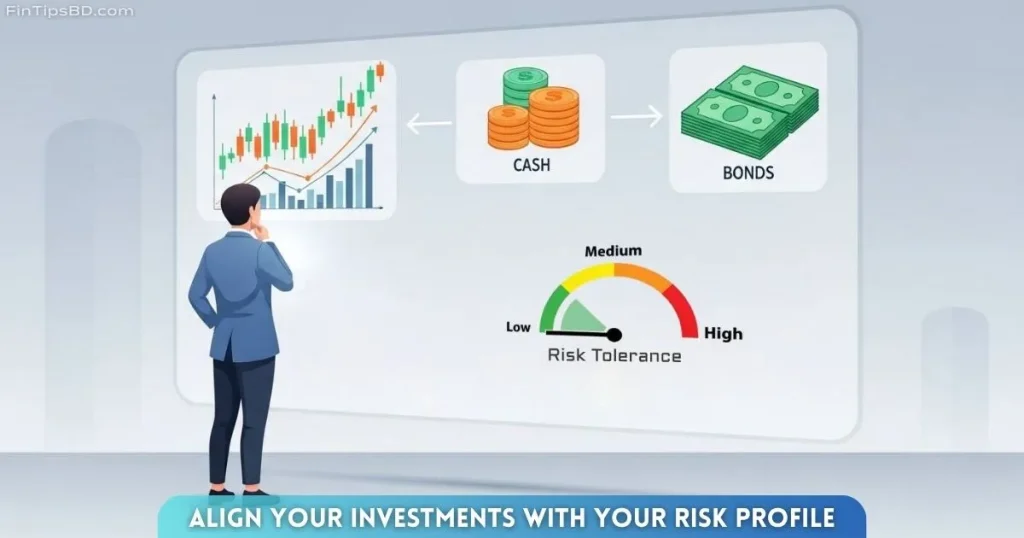The Shocking Truth About Risk And Return In Investing – Don’t Make This Mistake!

When it comes to building your wealth, grasping the concept of risk and return in investing isn’t just helpful—it’s absolutely essential. One of the most common errors that both beginners and experienced investors make is chasing big gains without thinking about the hidden pitfalls that come along with them. Many get caught up in the idea that larger profits automatically mean smarter investments. But here’s the harsh reality: every reward in the world of finance comes with a level of risk, and overlooking this balance can cost you dearly.
In this guide, we’ll explain the link between risk and return in investing in straightforward terms, using real-life examples and easy-to-follow tips that you can start using today.
Table Of Contents
What Is Risk in Investing, Really?
In simple terms, risk in investing means the chance of losing money or not earning the profit you expected. It’s the unpredictability that comes with putting your money into any financial opportunity. Whether you’re investing in stocks, property, or mutual funds, there’s always the possibility that things might not go your way.
There are several major investment risk types every investor should know:
- Market Risk: This is the danger that your investment might drop in value due to broad changes in the market—like an economic slowdown or a major political event.
- Inflation Risk: If your investment returns don’t beat inflation, your money buys less over time, reducing the real value of your gains.
- Liquidity Risk: Some investments, such as real estate or private companies, can’t be sold quickly without possibly losing value. This is a form of portfolio risk tied to how easily an asset can be turned into cash.
- Credit Risk: With bonds or other lending investments, this is the chance that the borrower won’t repay the money or interest owed.
- Interest Rate Risk: Particularly important for bondholders—when general interest rates climb, existing bonds offering lower rates become less attractive, and their market value falls.
Real-World Scenario: Imagine you put money into a company’s stock, hoping for a 10% return in a year. But the whole industry takes a hit, and your investment drops by 20% instead. That’s risk in motion—returns aren’t promised, and this shows how you could lose part of your capital.
Understanding Returns – What Are You Actually Making?
Return is the gain or loss you experience from your investment over time. It’s generally shown as a percentage of what you originally put in. But not all investment returns are created equal.
Here are the key types of returns you might earn:
- Capital Gains: The profit from selling an asset for more than you paid.
- Dividend Income: Ongoing payments from holding certain stocks or mutual funds.
- Interest Income: Money earned from bonds, savings products, or other loan-based instruments.
Let’s look at a quick example. If you invest $1,000 in a stock and it grows to $1,200 in a year, your capital gain is $200—giving you a 20% return. If that stock also pays a $50 dividend during the year, your total return becomes $250, or 25%.
Returns can be:
- Positive (Gains) – which is what most investors aim for
- Negative (Losses) – which every investor should be ready for
The Crucial Relationship Between Risk and Return in Investing
Here’s the key takeaway: you can’t expect high returns without accepting some level of risk. These two elements are directly tied together, showing the fundamental risk-return tradeoff. In general, the more risk you’re prepared to face, the higher your potential return—but also the greater the chance of losing money. This is the foundation of understanding risk vs reward.
Picture a seesaw:
- On one end, there’s risk, On the other, there’s return.
- As one goes up, the other typically rises too.
For example:
- Low-risk options like government bonds or high-interest savings accounts deliver smaller but steady returns. They’re seen as safer because they carry lower portfolio risk.
- High-risk options such as growth stocks, startups, or cryptocurrencies might bring in massive returns—but can also lead to heavy losses.
This relationship, known as the risk-return tradeoff, lies at the core of smart investing decisions.
The Shocking Truth: Most People Misunderstand This
A lot of investors—especially those just starting out—make the major mistake of focusing only on returns. They’re drawn to top-performing stocks or mutual funds without ever asking, “What kind of risk am I taking here?”
Here’s what they often forget:
- High returns aren’t promised; they’re only possible.
- A strong performance in the past doesn’t guarantee future success. A fund that did great last year might struggle this year.
- Letting emotions guide your decisions—like panic during a market crash or overconfidence when markets are booming—usually leads to poor results.
The hard truth? There’s no such thing as “free” return. Every potential reward comes with a price, and that price is risk.
How to Evaluate Your Own Risk Tolerance
Your personal risk tolerance is about how much market loss you can handle—both financially and emotionally—without abandoning your plan. It’s a key part of shaping the right asset allocation for your goals.
To figure out your comfort zone, try asking yourself these questions (think of it as a quick risk tolerance quiz):
- How would I really feel if my investments suddenly dropped by 20%?
- What’s my time horizon? (The longer your timeline, the more risk you may be able to handle.)
- Do I need this money soon (e.g., for a home purchase), or is it for long-term goals like retirement?
- Do I stress out over daily market changes?
Quick Guide to Investor Types:
- Conservative Investors: Focus on keeping their money safe, choosing low-risk options and accepting lower returns.
- Moderate Investors: Aim for a mix of safety and growth, ready to face some ups and downs for better long-term results.
- Aggressive Investors: Chase big growth opportunities and are okay with high market swings and possible short-term losses.
Knowing where you fall helps you build a strategy that fits your comfort level and makes sure your portfolio risk stays in line with your mindset.
Aligning Your Investments with Your Risk Profile

Once you’ve figured out your personal risk tolerance, the next step is building a mix of investments that matches it. This process is called asset allocation—deciding how to spread your money across various types of assets like stocks, bonds, and cash.
Here’s a general idea of how different investors might structure their portfolios:
Conservative Portfolio:
- Government-backed bonds and treasury securities
- High-interest savings or money market accounts
- Low-volatility mutual funds focused on steady income
Moderate Portfolio:
- Balanced mutual funds (mix of stocks and bonds)
- Reliable, dividend-paying stocks
- Diversified real estate investments like REITs
Aggressive Portfolio:
- Fast-growing stocks in new or developing sectors
- ETFs that focus on emerging markets
- Small, strategic exposure to riskier assets like cryptocurrency (handled carefully and in limited amounts)
Pro Tip: Always aim for a diversified portfolio—meaning you spread your investments across different asset types, industries, and countries. This helps cushion your losses if one area performs poorly, keeping your overall returns more stable.
Lessons from the Past: What History Teaches Us About Risk and Return in Investing
Looking back, history has given us plenty of examples showing the importance of understanding risk and return in investing:
- 2008 Financial Crisis: Global markets crashed, wiping out huge amounts of value. But those who stayed invested and remained patient often recovered and saw growth in the following years. This proves how important it is to have a long-term view.
- Dot-Com Bubble (2000): Many investors poured money into internet stocks without fully understanding what they were buying. When the bubble burst, they suffered major losses. It’s a clear warning about following trends blindly.
- COVID-19 Crash (2020): Markets dropped fast due to the pandemic but bounced back quicker than expected. Those who didn’t panic and held onto their investments typically came out ahead.
Each of these events shows that investors who know how risk and return in investing work—and who stick to a plan built around their personal tolerance—usually perform better over time.
Smart Ways to Handle Risk Without Giving Up Returns
Managing risk doesn’t mean avoiding it completely—it means being smart and intentional with your choices.
Here are a few ways to manage portfolio risk effectively:
- Diversify Smartly: Spread your money across asset types (stocks, bonds, real estate, etc.), industries, and global markets. Diversification is key to protecting your overall return.
- Stick to Your Plan: Don’t let market ups and downs push you into emotional decisions. Focus on your long-term goals, not short-term noise.
- Keep an Emergency Fund: Having quick access to cash means you won’t be forced to sell your investments at a bad time just to cover unexpected bills.
- Rebalance Regularly: Review your portfolio now and then. If one area has grown too large, sell a portion and reinvest elsewhere to stay aligned with your original asset allocation plan.
- Keep Learning: The more you know about economic trends, investment tools, and financial planning, the better choices you’ll make—and the fewer costly errors.
The One Mistake That Could Destroy Your Wealth
If you only take away one thing from this article, make it this: Never invest by looking at returns alone.
Ignoring risk is the fastest way to lose everything you’ve built. It’s not just about how much you can make—it’s also about what you might lose and how you’ll handle it when things go wrong. Your financial future depends on understanding the delicate balance of risk and return in investing.
Final Thoughts: Invest with a Clear Mind, Not Emotion
Investing isn’t a game—it’s a long-term journey. When you understand how risk and return in investing work together, you’ll make better decisions, avoid big mistakes, and build wealth that lasts.
Start by figuring out your own risk tolerance. Choose investments that fit your financial goals and emotional comfort zone. Make sure your asset allocation reflects that. And remember—no matter how tempting a high return seems, it’s never free. Every potential reward comes with risk, and wise investors always respect that.
